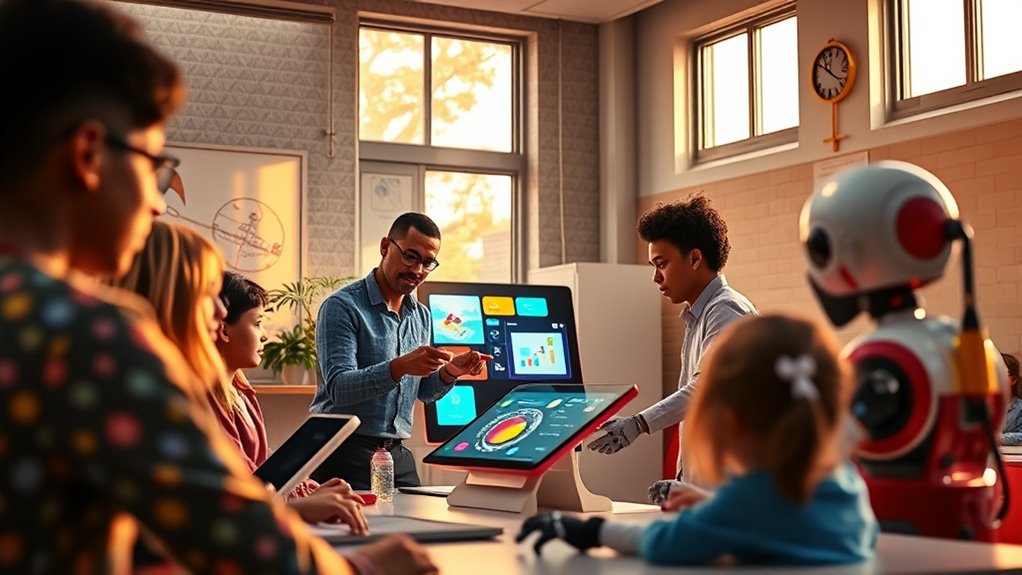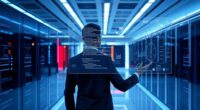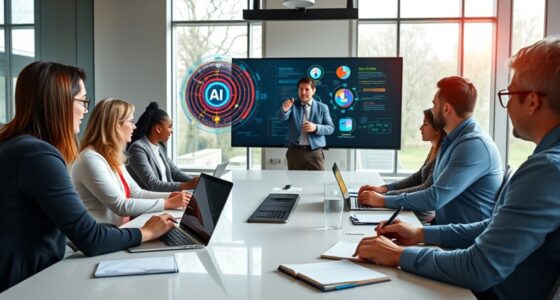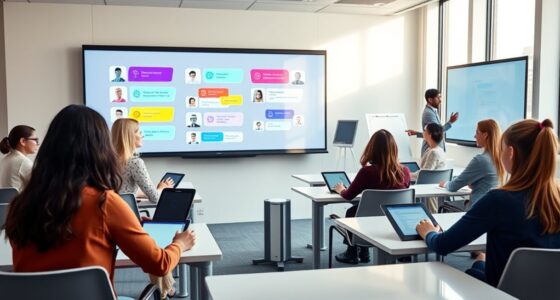Teaching adaptation helps you harness AI as a job creator by focusing on developing skills in areas like creative problem-solving, communication, and collaboration, alongside technical expertise. When you learn to adapt, you position yourself to work alongside AI, enhancing productivity and opening new opportunities. This approach shifts AI’s role from job displacement to job transformation. Keep exploring, and you’ll discover how strategic learning can turn AI into a catalyst for growth.
Key Takeaways
- Incorporating soft skills training helps workers complement AI, increasing their value and job security.
- Emphasizing continuous learning enables workers to adapt to new AI-driven roles and technologies.
- Collaboration between education and industry ensures curricula align with evolving AI skill demands.
- Teaching creative problem-solving and human oversight transforms AI from a threat into a tool for innovation.
- Supporting retraining programs allows workers to transition into emerging AI-related roles, fostering job creation.
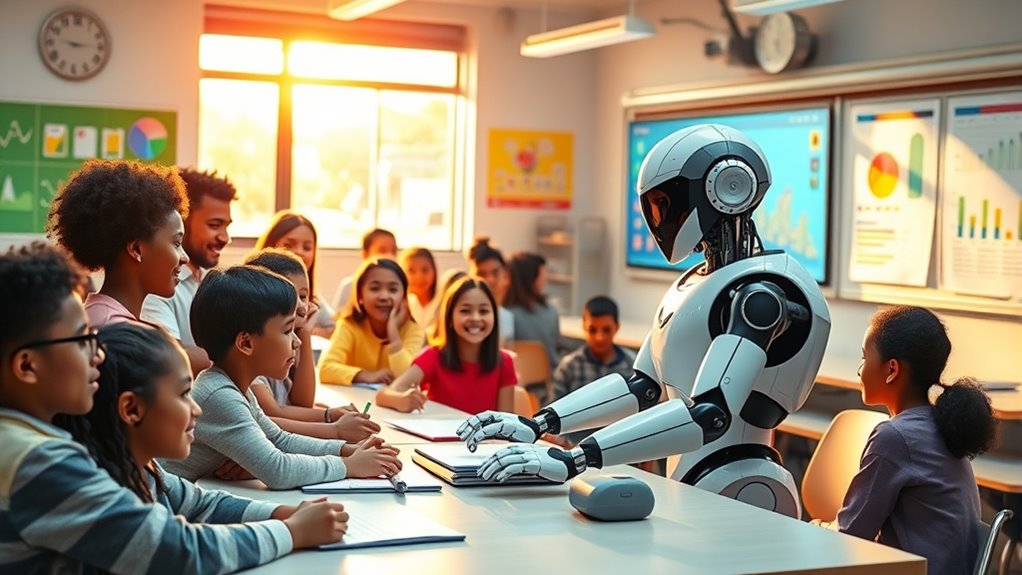
As AI continues to reshape the labor market, it’s clear that workers must adapt quickly to stay relevant. The rapid adoption of AI technologies has led to increased unemployment in high-exposure roles, particularly in computer and mathematical fields, from 2022 through 2025. However, this disruption isn’t inevitable; it’s an opportunity to transform the way we approach workforce development. New AI-related roles, such as AI Engineer, Prompt Engineer, and AI Content Creator, are emerging at a remarkable pace, with growth rates surpassing 130% in 2025. This shift indicates that instead of replacing jobs, AI is creating a demand for specialized skills that require human oversight, creativity, and judgment.
Teaching adaptation becomes essential in this environment. By equipping workers with AI fluency and technical skills, you can help them pivot toward these new opportunities. It’s not just about learning technical skills—developing strengths in communication, leadership, and empathy is equally indispensable. These human skills are becoming more valuable as AI’s capabilities expand, making workers more irreplaceable in roles that combine technical expertise with soft skills.
Emphasize human skills like communication, leadership, and empathy to complement AI expertise and enhance workforce resilience.
The surge in AI job postings, which increased by over 25% in early 2025, underscores the growing need for a workforce that understands and works alongside AI. Demand for generative AI skills has skyrocketed, especially in non-IT roles, multiplying nearly ninefold since 2022. Sectors like design and manufacturing are integrating AI deeply, and workers must retrain to stay competitive. Fast-growing roles such as Data Scientists and Machine Learning Engineers demand ongoing learning and specialized training, emphasizing the importance of teaching adaptation. Furthermore, understanding the impact of AI on employment can help workers and policymakers better prepare for the future of work, ensuring a balanced approach to technological progress.
To counter displacement, training programs need to expand beyond technical knowledge. Upskilling efforts should focus on creative problem-solving, collaboration, and judgment—areas where humans excel. Partnerships between educational institutions and industries are indispensable to ensure curricula stay aligned with evolving AI demands. Increasing AI literacy across sectors can help workers complement AI technologies instead of competing with them, transforming AI from a job killer into a job creator. Recent studies also show that the overall productivity gains from AI adoption can lead to economic growth and new employment opportunities, provided workers are supported through continuous learning initiatives. Ultimately, fostering continuous learning and adaptability prepares you to thrive amid AI-driven change.
Frequently Asked Questions
How Can Educators Effectively Incorporate AI Into Their Curriculum?
You can effectively incorporate AI into your curriculum by integrating AI tools that personalize learning and promote critical thinking. Start with clear policies and ethical guidelines to address privacy and academic integrity. Provide professional development to enhance your AI skills and stay updated on best practices. Engage students in discussions about AI’s role and teach them how to use AI responsibly. This approach boosts engagement, prepares students for future careers, and keeps your teaching relevant.
What Skills Will Workers Need to Adapt Alongside AI Advancements?
You’ll need to sharpen your data literacy, so you can ask AI the right questions and analyze its insights. Critical thinking becomes your compass, guiding you through complex AI-generated data. Soft skills like communication and collaboration act as your bridge to work effectively with AI. Embrace continuous learning, stay ethically aware, and develop AI fluency. These skills transform AI from a threat into a powerful engine fueling your career growth.
How Can Small Businesses Leverage AI for Job Creation?
You can leverage AI to create new jobs by automating routine tasks, freeing your staff to focus on higher-value activities like strategy and customer engagement. Use AI for content creation, marketing, and customer support, which can expand your team’s roles. Invest in training your employees to oversee AI systems, analyze data, and improve user experiences. This approach not only boosts efficiency but also fosters innovation and new employment opportunities within your business.
What Policies Support Workforce Adaptation to AI Changes?
You can support workforce adaptation by advocating for policies that improve data collection, enabling real-time monitoring of AI impacts. Push for modernized education curricula that include AI literacy and soft skills. Promote social safety nets like unemployment benefits, health coverage, and retraining programs to help displaced workers. Encourage incentives for AI-related training and public-private partnerships, ensuring a balanced approach that fosters innovation while safeguarding jobs and promoting equitable economic growth.
How Does AI Impact Regional Employment Disparities?
Imagine two regions: one thriving with AI-driven opportunities, glowing with innovation, and another struggling to keep pace, shadows cast by missed digital infrastructure. You see AI widen employment gaps, favoring urban, tech-rich areas while rural regions lag behind. This disparity amplifies existing income inequalities, leaving some communities behind. To bridge this divide, targeted policies and workforce adaptation are essential, transforming AI from a source of inequality into a tool for inclusive growth.
Conclusion
By embracing teaching adaptation, you help shape AI into a tool that opens doors rather than closes them. Imagine a future where your efforts plant seeds of new opportunities, turning the landscape of work into a vibrant garden of innovation. As you guide AI’s growth, you become a gardener nurturing a flourishing ecosystem—one where jobs blossom and thrive, transforming uncertainty into endless possibilities. Together, you can turn the tide and make AI a job creator, not a killer.
